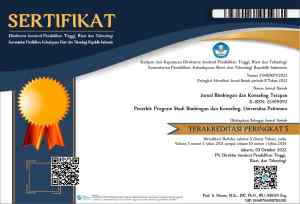Nomophobia and Self-Esteem: A Study of Migrant Students' Psychological Well-Being
Abstract
The transition from high school to higher education represents a significant milestone for adolescents, often accompanied by migration to access better educational opportunities, known as "merantau." This phenomenon, prevalent among students aged 18-24, is associated with a high prevalence of nomophobia, characterized by anxiety and discomfort when separated from smartphones. This study aims to explore the relationship between self-esteem and nomophobia tendencies among migrant students, given the mixed findings in existing literature. Employing a correlational quantitative research design, data were collected from 153 migrant students using the Nomophobia Questionnaire (NMP-Q) and the State Self-Esteem Scale (SSES). Descriptive analysis revealed that 74.5% of students exhibited moderate nomophobia tendencies, while 62.7% had high self-esteem. Pearson's correlation analysis indicated a significant negative relationship between self-esteem and nomophobia tendencies (r = -0.222, p = 0.006), suggesting that higher self-esteem is associated with lower nomophobia tendencies. This finding underscores the importance of enhancing self-esteem to mitigate nomophobia, highlighting the role of positive self-perception and real-life social interactions. Despite limitations such as the online data collection method, this study provides valuable insights into the psychological dynamics between self-esteem and nomophobia among migrant students, advocating for targeted interventions to address these issues.
Keywords
Full Text:
PDFReferences
Adawi, M., Bragazzi, N. L., Argumosa-Villar, L., Boada-Grau, J., Vigil-Colet, A., Yildirim, C., Del Puente, G., & Watad, A. (2018). Translation and Validation of the Nomophobia Questionnaire in the Italian Language: Exploratory Factor Analysis. JMIR MHealth and UHealth, 6(1), 1–9.
Aguilera Manrique, G., Márquez Hernández, V. V., Alcaraz Córdoba, T., Granados Gámez, G., Gutiérrez Puertas, V., & Gutiérrez Puertas, L. (2018). The relationship between nomophobia and the distraction associated with smartphone use among nursing students in their clinical practicum. PLoS ONE, 13(8), 1–14. https://doi.org/10.1371/journal.pone.0202953
Armstrong, L., Phillips, J. G., & Saling, L. L. (2000). Potential determinants of heavier Internet usage. International Journal of Human Computer Studies, 53(4), 537–550. https://doi.org/10.1006/ijhc.2000.0400
Aziz, A. (2019). No Mobile Phone Phobia dikalangan Mahasiswa Pascasarjana. KONSELI: Jurnal Bimbingan Dan Konseling (E-Journal), 6(1), 1–10. https://doi.org/10.24042/kons.v6i1.3864
Azizah, A. N., & Rahayu, S. A. (2016). Hubungan Self-Esteem dengan Tingkat Kecenderungan Kesepian Pada Lansia. Jurnal Penelitian Psikologi, 7(2), 40–58.
Baron, R. A., & Branscombe, N. R. (2012). Social Psychology (13 th ed.). Library of Congress Caraloging-in-Publication Data.
Baron, R. A., & Byrne, D. (2005). Psikologi Sosial, Jilid 2, Edisi Kesepuluh. Jakarta: Erlangga.
Bhattacharya, S., Bashar, M. A., Srivastava, A., & Singh, A. (2019). Nomophobia: NO MObile PHone PhoBIA. Journal of Family Medicine and Primary Care, 8(49), 1297–1300. https://doi.org/10.1051/psyc/202049049
Bianchi, A., & Philips, J. G. (2005). The Impact of the Internet, Multimedia and Virtual Reality on Behavior and Society. Cyber Psychology and Behavior, 8(1), 39–51.
Bragazzi, N. L., & Del Puente, G. (2014). A proposal for including nomophobia in the new DSM-V. Psychology Research and Behavior Management, 7, 155–160. https://doi.org/10.2147/PRBM.S41386
Dalimunthe, M. (2021). Hubungan Antara Self Esteem Dengan Kecenderungan Nomophobia Pada Mahasiswa Psikologi di Universitas Medan Area. Universitas Medan Area.
Delamater, J. D., & Myers, D. J. (2011). Social Psychology, Seventh Edition. In WADSWORTH CENGAGE Learning. https://doi.org/10.4324/9780429493096
Ehrenberg, A., Juckes, S., White, K. M., & Walsh, S. P. (2008). Personality and self-esteem as predictors of young people’s technology use. Cyberpsychology and Behavior, 11(6), 739–741. https://doi.org/10.1089/cpb.2008.0030
Farhan, Y. T., & Rosyidah, R. (2021). Hubungan Antara Self-Esteem Dengan Kecenderungan Nomophobia Pada Mahasiswa Perempuan Di Surabaya. Personifikasi: Jurnal Ilmu Psikologi, 12(2), 162–179. https://doi.org/10.21107/personifikasi.v12i2.11921
Ghufron, M. N., & Risnawita, R. S. (2010). Teori-Teori Psikologi.
Heatherton, T. F., & Polivy, J. (1991). Development and Validation of a Scale for Measuring State Self-Esteem. Journal of Personality and Social Psychology, 60(6), 895–910. https://doi.org/10.1037/0022-3514.60.6.895
Jilisha, G., Venkatachalam, J., Menon, V., & Olickal, J. J. (2019). Nomophobia: A Mixed-Methods Study on Prevalence, Associated Factors, and Perception among College Students in Puducherry, India. Indian Journal of Psychological Medicine, 41(2), 138–143. https://doi.org/10.4103/IJPSYM.IJPSYM
Kandell, J. J. (1998). Internet Addiction on Campus: The Vulnerability of College Students. Cyber Psychology and Behavior, 1(1), 11–17. https://doi.org/https://doi.org/10.1089/cpb.1998.1.11
Kemendikbud. (2020). Statistik Pendidikan Tinggi (Higer Education Statistic) 2020. PDDikti Kemendikbud, 81–85. https://pddikti.kemdikbud.go.id/publikasi
King, A. L. S., Valenca, A. M., Silva, A. C. O., & Tathiana. (2013). Nomophobia: Dependency on virtual environments or social phobia? Computers in Human Behavior, 29(1), 140–144. https://doi.org/https://doi.org/10.1016/j.chb.2012.07.025
Maryani, D. N., Dewi, E. M. P., & Nurdin, M. N. H. (2021). Hubungan antara Harga Diri dan Nomophobia pada Mahasiswa. Jurnal Psikologi Talenta Mahasiswa, 1(1).
Minchinton, J. (1993). Maximum Self-Esteem: The Hand Book for Reclaiming Your Sense of Self Worth. Kuala Lumpur: Golden Books Center Sdn, Bhd.
Monks, F. J., Knoers, A. M. P., & Haditono, S. R. (2002). Psikologi Perkembangan: Pengantar dalam Berbagai Bagiannya. Yogyakarta: Gadjah Mada University Press.
Mruk, C. J. (2006). Self-Esteem Research, Theory, and Practice: Toward A Positive Psychology of Self-Esteem. New York: Springer Publishing Company, Inc.
Muyana, S., & Widyastuti, D. A. (2017). Nomophobia (No-Mobile Phone Phobia) Penyakit Remaja Masa Kini. Seminar Nasional Bimbingan Konseling Universitas Ahmad Dahlan, 2, 280–287. http://seminar.uad.ac.id/index.php/snbkuad/article/view/84
Nurrahmah, Florentina, T. P., & Radde, H. A. (2021). Harga Diri, Regulasi Emosi, dan Perilaku Asertif pada Mahasiswa. Jurnal Psikologi Karakter, 1(1), 7–16. http://https//journal.unibos.ac.id/jpk7
Pavithra, M. B., Madhukumar, S., & Murthy T S, M. (2015). a Study on Nomophobia-Mobile Phone Dependence, Among Students of a Medical. National Journal of Community Medicine, 6(2), 340–344.
Prautami, D. P., & Halimah, L. (2021). Hubungan Antara Self-Esteem dengan Nomophobia (No Mobile Phone Phobia) pada Remaja Kota Bandung. Prosiding Psikologi, 159–163. http://dx.doi.org/10.29313/.v0i0.28217
Ramaita, Armaita, & Vandelis, P. (2019). Hubungan Ketergantungan Smartphone dengan Kecemasan (Nomophobia). Jurnal Kesehatan, 10(2), 89–93.
Ridha, A. A. (2018). Task Commitment pada Mahasiswa Suku Bugis yang Merantau. Jurnal Psikologi, 45(1), 66–76. https://doi.org/10.22146/jpsi.31094
Salam, B. (2004). Cara Belajar yang Sukses di Perguruan Tinggi. Jakarta: PT Rineka Cipta.
Saputri, N. S., Rahman, A. A., & Kurniadewi, E. (2018). Hubungan Antara Kesepian Dengan Konsep Diri Mahasiswa Perantau Asal Bangka Yang Tinggal Di Bandung. Psympathic : Jurnal Ilmiah Psikologi, 5(2), 645–654. https://doi.org/10.15575/psy.v5i2.2158
Sharma, B. (2012). Adjustment and Emotional MaturityAmong First Year College Students. Pakistan Journal of Social and Clinical Psychology, 10(2), 32–37.
Srisayekti, W., & Setiady, D. A. (2015). Harga-diri (Self-esteem) Terancam dan Perilaku Menghindar. Jurnal Psikologi, 42(2), 141. https://doi.org/10.22146/jpsi.7169
Sudarji, S. (2017). Hubungan Antara Nomophobia Dengan Kepercayaan Diri. Jurnal Psikologi Psibernetika, 10(1), 51–61. https://doi.org/10.30813/psibernetika.v10i1.1041
Sugiyono. (2017). Metode Penelitian. Bandung: Penerbit Alfabeta.
Syahputra, Y., & Erwinda, L. (2020). Perbedaan Nomophobia Mahasiswa; Analisis Rasch. JPPI (Jurnal Penelitian Pendidikan Indonesia), 6(2), 69–76. https://doi.org/10.29210/02020616
Yildirim, C. (2014). Exploring The Dimensions Of Nomophobia: Developing and validating a questionnaire using mixed methods research. In Iowa State University.
Yildirim, C., & Correia, A.-P. (2015). Exploring the dimensions of nomophobia: Development and validation of a self-reported questionnaire. Computers in Human Behavior, 49, 130–137. https://doi.org/https://doi.org/10.1016/j.chb.2015.02.059
Zhiqi, Y., Yingru, Z., Lu, Z., Yu, X., & Xuelian, C. (2019). How does self-esteem affect mobile phone addiction? The mediating role of social anxiety and interpersonal sensitivity. Psychiatry Research, 271, 526–531. https://doi.org/https://doi.org/10.1016/j.psychres.2018.12.040
DOI: http://dx.doi.org/10.30598/jbkt.v8i2.2014
Refbacks
- There are currently no refbacks.

This work is licensed under a Creative Commons Attribution 4.0 International License.
Published by:
Pattimura University
Address: Department of Guidance and Counseling, Faculty of Teacher Training and Education Science (FKIP).
Jl. dr. Tamaela, Ambon - Mollucas -Indonesia
Ph. +628114378333
Home page: http://ojs.unpatti.ac.id/index.php/bkt/index
e-mail: paul.arjanto@lecturer.unpatti.ac.id
Jurnal Bimbingan dan Konseling Terapan is licensed under a Creative Commons Attribution 4.0 International License.




















